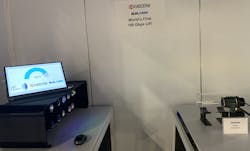The LED industry has had a tough time establishing its wares for Li-Fi — a Wi-Fi alternative that uses light rather than radio frequencies to transmit. Now, things just got more challenging, as a major vendor from the laser industry demonstrated a system that transmits 100 times faster than any LED demo.
Kyocera SLD Laser (KSLD) showed a laser Li-Fi system at the recent CES exhibition in Las Vegas in which a transmitter delivered data at 100 gigabits per second. That trounces the 1 Gbps that LED Li-Fi pioneer pureLiFi has shown.
While that’s potentially good news in general for Li-Fi, it could help hasten the end of the LED approach.
Before getting too carried away, we should note that the KSLD system transmitted only over a short distance of about a meter-and-a-half. And it utilized a boxy contraption (see photo) rather than any sleekly designed finished product. Miniaturization of a 100-Gbps product is still a few years away, although KSLD over the last year started offering a finished product at somewhere between 1 and 2 Gbps, which it makes available to systems developers for applications such as onboard Li-Fi on planes and for vehicle communications.
By comparison, LED Li-Fi providers such as Edinburgh-based pureLiFi and Signify have been offering commercial products for several years, and they are small enough to serve laptops, tablets, and phones. Earlier this week LEDs Magazine reported on a recent Signify installation at a Long Island school. In December, the US Army re-upped with pureLiFi.
But Li-Fi, which dates back to at least 2012 when then University of Edinburgh professor Harald Haas co-founded pureLiFi, has endured slow commercial progress. Vendors are indeed selling product but typically into small settings. Mass adoption has eluded them, in large measure because most gadget makers have not embedded Li-Fi circuits. Li-Fi end users generally have to attach inconvenient dongles.
And while Li-Fi offers various potential advantages over Wi-Fi, it does not, in its LED form, clearly trump Wi-Fi on speed. Li-Fi can be faster than Wi-Fi but is not always. pureLiFi has demonstrated a gigabit per second under controlled conditions, but real-world installations typically run slower. The Long Island school in Signify’s orbit is believed to have installed a 150-Mbps-rated system; real running times would probably be slower.
That is the primary reason why some experts believe that LEDs will give way to lasers and their superior speed as the future of Li-Fi, especially as developers like KSLD begin to miniaturize their products.
Laser enthusiasts include none other than the Nobel-winning co-inventor of the blue LED Shuji Nakamura, who co-founded Santa Barbara-based SLD Laser. Japan’s Kyocera acquired SLD a year ago, creating KSLD, the company that showed the 100-Gbps laser system at CES.
Nakamura is not the only LED legend now identified with laser Li-Fi. The same might be said of Haas, widely regarded as the father of Li-Fi for his pioneering work with LED-based Li-Fi. While still serving as chief scientific officer for pureLiFi, he is now also a senior advisor to KSLD, helping the company with laser Li-Fi development.
Haas works in that capacity not with his pureLiFi hat on but via academia. The professor changed universities in July 2020, departing Edinburgh to become distinguished professor of mobile communications at the University of Strathclyde in Glasgow, where he is also the director of the LiFi Research and Development Centre.
Haas has long had an eye for laser communications. In fact, pureLiFi itself acknowledged to LEDs Magazine last summer that “laser light will better serve Li-Fi”. It has developed a laser Li-Fi chip designed as an antenna for embedding in phones and for use as a transmitter.
KSLD and pureLiFi have not announced any partnership.
The 100 Gbps that KSLD showed at CES is five times the speed of its previous fastest demonstration of 20 Gbps.
It could well be that the future has a place for Li-Fi. It’s just that the “light emitting diodes” that drive it forward could be lasers, rather than what the industry calls LEDs.
LEDs Magazine recently interviewed both Haas and KSLD senior vice president `of business development Paul Rudy, a co-founder of SLD. We will bring you more on this story, including a look at how the CES demo worked, the possible applications for the KSLD Li-Fi technology (spoiler: think avionics, for one), and a look at whether the technology will also be used for illumination (spoiler: yes and no).
MARK HALPER is a contributing editor for LEDs Magazine, and an energy, technology, and business journalist ([email protected]).
For up-to-the-minute LED and SSL updates, why not follow us on Twitter? You’ll find curated content and commentary, as well as information on industry events, webcasts, and surveys on our LinkedIn Company Page and our Facebook page.

Mark Halper | Contributing Editor, LEDs Magazine, and Business/Energy/Technology Journalist
Mark Halper is a freelance business, technology, and science journalist who covers everything from media moguls to subatomic particles. Halper has written from locations around the world for TIME Magazine, Fortune, Forbes, the New York Times, the Financial Times, the Guardian, CBS, Wired, and many others. A US citizen living in Britain, he cut his journalism teeth cutting and pasting copy for an English-language daily newspaper in Mexico City. Halper has a BA in history from Cornell University.





